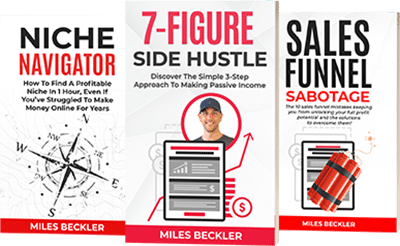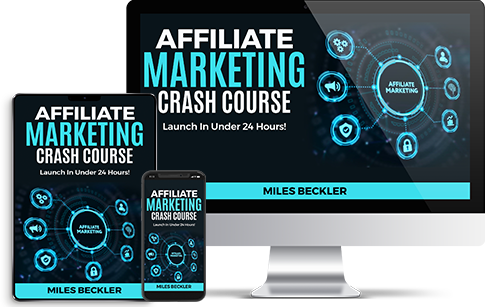This post reveals exactly how to rank videos on the top of the YouTube search engine so you can grow your channel, earn more views and explode your subscriber base.
Being a pro-level SEO tutorial and attempting to respect your time with a concise post, I’m going to stay focused on what is unique for YouTube.
The YouTube algorithm works so similarly to Google that everything from my learn SEO deep dive is applicable with a few key tweaks since YouTube has thumbnails, videos, etc.
In this post, you'll first get an overview of the basics of video seo to make sure you understand what the main ranking factors are before moving on to the advanced strategy with extremely clear step-by-step detail.
From here you will learn the process that allows you to optimize your videos to maximize your results in the second largest search engine in the world, YouTube.
Here's what you'll learn in this post:
- The Potential of Video SEO
- Keyword Research
- YouTube Ranking Factors
- Publishing Your Video
- Optimizing Your Video
- Pro-Level Video Optimization Software
I recommend you go through all of the steps in order because they build on each-other.
If you jump straight to the YouTube SEO software for the step-by-step tutorial, but you don’t fully understand search intent, or you don’t get the ranking factors, THE PRO-LEVEL STRATEGY WON’T WORK.
Sorry for yelling…
But you must understand how each layer of Video SEO works together with the other pieces BEFORE you can successfully optimize your videos like a pro.
This post will walk you through the whole process and I have one promise.
I will not PITCH YOU on a video SEO course like the other wankers out there. 100% of the how to information is free, because I have a business and I don’t need to sell you a YouTube SEO course.
Ok, ready to dig in?
Great!
The Big Picture – Video SEO Potential
If you really dig in and bust your ass publishing highly optimized videos… What’s the potential?
How about earning over 80,600 subscribers and 3,700,000+ views without having to pay the piper for views, reach or engagement? (Eat that Zuckerberg)
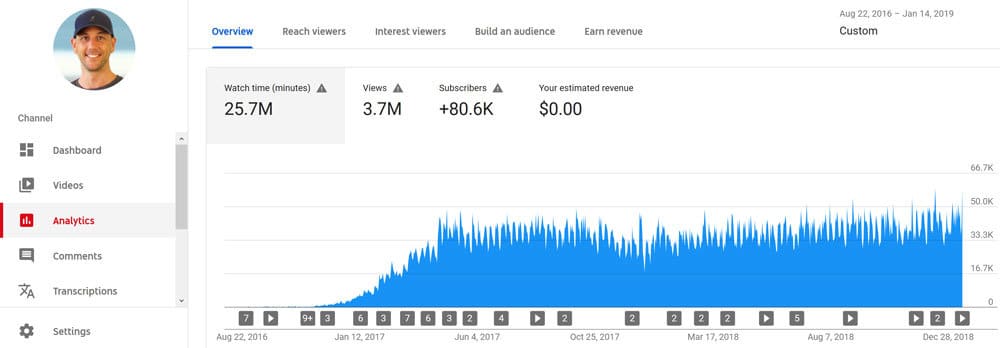
Personally, I prefer earned traffic or organic traffic… This is precisely the type of traffic you can grow through a highly optimized YouTube channel with hundreds of optimized videos.
The main benefit from organic search traffic (whether it is from Google or YouTube) is that you will receive traffic for months and years to come after publishing your videos.
Videos I published in 2016 and 2017 are still driving massive amounts of traffic for me today…
And they will continue to drive audience growth, email list growth and traffic growth through 2021, 2025 and beyond!
Residual rewards for the work you do once!
And if you are wondering how YouTube stacks up to the other platforms… Here are some quick YouTube stats.
- 1.9 billion Monthly Active Users
- Over 1 billion videos viewed every day
- Billions of hours watched every day
There is a nearly infinite traffic and audience growth potential here and video SEO is your key to reaching more and more people every day.
Plus you can get started with your cell phone or your laptop's web-cam if you'd like… That's how I started.
Obiously if you want to get a DSLR and high quality microphone you can, but I've proven through over 500 videos with either a webcam or my cell phone's front-facing camera… Expensive camera equipment is not required.
What is required?
Learning a proven process that get's YouTube's algorithm to fall in love with your videos, your titles, your descriptions etc…
And that's EXACTLY what you are going to learn next…
Keyword Research – The Cornerstone Of Your Video SEO Strategy
When executing your video marketing strategy with SEO you always need to begin with the end viewer in mind…
Specifically, you need to ask yourself these two questions and you need to get extremely clear about the answers before creating your content or optimizing your video.
- What is the phrase that they’re searching YouTube for?
- Why are they searching that specific phrase, today?
Question number one is simple… This leads us to keyword research.
Keyword Research For Video Marketing
Now, you starting know that keyword research is the core skill you need to build within the greater framework of SEO in order to drive large volumes of traffic.
If you’re not optimizing your videos for the right keywords, no one will find you.
The big reason why that analytics image above shows my channel has grown to millions of views with tens of millions of minutes watched and over 80,000 subscribers is because I did keyword research every time.
I personally use a paid keyword research tool you can find here and I show you exactly how to use this tool in order to find the high search volume and low difficulty keyword phrases in the following video:
The reason why I have been happily paying monthly for this tool is because it analyzes the organic keyword difficulty for me and it is super focused.
Other keyword tools try to do 10,000 other things and I prefer simple tools that have laser-like focus on one specific job.
Just like a woodcarver would never use an all in one tool that tries to do everything… They have a very specific tool for each type of cut.
If you don’t have a budget for a paid keyword tool, click here for my full step-by-step tutorial on the free keyword tool alternative.
The key take away for you at this point is that keyword research is not optional for video SEO. You must be doing keyword research each and every time you publish an optimized video!
Once you have the keyword research completed, that takes you to the second question…
Question #2 – “Why Are They Searching That Specific Phrase Today?”
It is not enough to only focus on the core keyword phrase without considering the individual who searched and their current situation.
This is known as keyword search intent and as YouTube’s algorithm continues to get smarter, the intent behind the keyword search phrase is becoming more and more important.
Think of it this way…
YouTube makes money when viewers search for videos, click and then they get to display advertising.
(This above line is the KEY TO EVERYTHING! Always remember YouTube's goals!!!!)
If that user has a poor experience because the videos are not relevant to what they searched… They leave YouTube and YouTube won’t make money.
On the other hand, when that user has a great experience…
They search for their phrase with the specific intent, they find a video that answered that question and they get suggested several other videos they also watch…
YouTube has just created the opportunity to display several advertisements because they got the intent correct!
This part is a little more abstract and it requires critical thinking and a clear understanding of your customer avatar.
This video explains keyword search intent:
Do This BEFORE You Make Your Video!
I always search the keyword phrases in Google and YouTube both, before creating a video on them to see what the algorithms think is relevant for that exact phrase.
Here I’m looking to make sure that the “video idea” I had in mind is relevant to what the search engines are displaying.
You may find keyword phrases that have great search volume and difficult is course, but when you actually search them you find its the name of a magazine or book you’ve never heard of…
You may find that it’s the name of a branded product and the first page is cluttered with Amazon listings and Amazon reviews whereas you thought it was a “how-to” type phrase.
The key take away here is your YouTube keywords and Tags and the intent behind the keyword needs to be in alignment with what the algorithm is are displaying in the search engine results page!
YouTube’s Algorithm & Ranking Factors
Compared to the Google algorithm, YouTube has some key distinctions when it comes to SEO.
Off page factors are much less important (back links don’t really matter much) whereas on Google they are still one of the top ranking factors.
There is no AI that can watch your video and understand how much value you are delivering to their audience… So YouTube leverages other data points instead.
These key data points that YouTube leverages to analyze the quality of your videos are:
- Click-Through Rate
- Video engagement
- View duration & Percentage completion
- Session duration
Next you'll get each one of these broken down so you understand how they all work together to bring you more video views and subscribers!
The 4 Steps To Creating a great video for the YouTube algorithm.
Since YouTube can’t actually understand what you’re saying in your video they are watching the data points they have access to based on user behavior.
They are monitoring the on page experience from a purely data driven perspective to try to understand if you’re creating engaging content that is worth watching or if you’re publishing rubbish.
At this point you may be thinking “But Miles, what about keyword optimization of my title… And tags?”
We will get there… But, before you publish the video you need to record the video and we want to make sure the video is created in a way that maximizes these engagement data points.
#1 – Click Through Rate
When YouTube displays your video next to your competitors video because they are both relevant to the search intent… Who does that viewer choose?
If the viewer chooses your competitors videos over you… Meaning they click through your competitors video more often than yours, your competitors will outrank you.
If the viewer chooses your video more often than your competitors videos, you will move up in the rankings on YouTube plus you will get displayed more through the browse and suggested videos features.
We are going to geek out on click your rates later, but right now you need to know the basics.
Most important components for click through rate
- A compelling video title that triggers the viewer emotionally with the feeling that they have finally found the answer they’ve been searching for!
- The first 120 characters of your video description must reinforce that user’s decision to choose your video. These first characters of your description also display in the YouTube search results page.
- Your thumbnail is the most visually attractive (or repulsing) part of your video and having a thumbnail that captures attention, leverages contrast to attract the eye, and builds curiosity for the viewer to click is key.
In a minute you will learn how to optimize these factors, but right now you just need to know what factors YouTube is tracking!
#2 – Video Engagement
YouTube gives viewers a few ways to engage on videos that help the YouTube algo learn whether the content is creating a positive experience or negative experience.
- Thumbs up
- Thumbs down
- Share feature
- Save to playlists
- Comments
- Subscribes
- Back button
- Other videos
These are all very self-explanatory.
Videos that get lots of thumbs ups, shares, comments, subscribes and get added to playlists are highly engaged videos.
YouTube prefers to show highly engaged videos versus neutral or negatively engaged videos.
The thumbs down feature, clicking ‘back’ or clicking another suggested video instead of watching yours how users are telling YouTube’s algorithm directly “I don’t like this video”
A simple hack to boost engagement on your videos:
Asking users and easy “yes” or “no” question at the beginning of your video is a great prompting to increase the number of comments.
You can also ask them to click the thumbs up and subscribe buttons at this time.
Generally you want to position this engagement date within your video as a “value” to your viewers by positioning the question as “I’m curious if you want me to make more videos about this topic?”
What Most Do WRONG
The highest percentage of viewers will watch the first minute of your video compared to the last minute of your video.
Most people wait until the end to ask for engagement and most of their viewers have dropped off…
This means the call to action for engagements is not seen by most of the viewers.
Moving your engagement request to the front of the video will massively increase the number of engagements.
Here is a video where I execute this method in the first minute for you to model… (Just watch the first minute of this one)
In the video creation process I am always focused on getting the users the information they want as quickly as possible without wasting time.
Our attention spans are shorter than ever and YouTube is constantly displaying other relevant videos and a 10 second tangent or an unnecessarily long intro gives the viewer the attempt to click back.
Key take away: Creating highly engaged videos that prompt users within the first minute to take the positive engagement actions will help you show the algorithm your video deserves more views!
Next you need to learn how to keep your viewer's attention for the rest of your video!
#3 – View Duration & Video Completion Percentage
YouTube is constantly monitoring how much of your videos your viewers are watching.
In order to protect their algorithm against click farms gaming the view numbers they look at two specific metrics.
First is the view duration… The actual number of minutes and seconds view on your video.
Second is the video completion percentage… The actual percent of your video watched.
They are monitoring both because a 30 second video that has a 90% view rate receives less time on site then a five-minute video that receives a 50% view rate.
Teasing topic ideas at the beginning that you expand upon at the end is a great way to compel your audience to increase their view duration.
Stating a simple line like “…And at the end of this video you'll learn the #1 trick to make this all fast and easy” at the beginning of your video will open a loop in your viewer's mind and compel them to stick around longer.
Eliminating unnecessarily long intros, outros and editing out random tangents will keep your videos focused and efficient, so users stay engaged and watch longer.
Remember… The back button or a suggested video are one mouse click away. If you wander off subject too much or waste 30 seconds of my time with a dubstep intro video, I’m out!
#4 – Session Duration
Many people think the goal of a great YouTube video is to drive that viewer off of YouTube onto your landing page and into the top of your funnel.
While there is always a time and place for specific videos to have calls to action, most videos should focus on keeping the user watching more YouTube videos.
Now, if this sounds counter-intuitive… All you need to do is look at this metric through YouTube’s eyes.
When that viewer watches 10 videos, YouTube has the opportunity to show more ads than if that viewer watched your one video and left.
If your channel and videos enable users to watch many videos and a high session duration, you will be rewarded with more exposure through the YouTube algorithm.
If your videos constantly drive viewers off of YouTube, you will get suppressed by YouTube’s algorithm.
Now, I do include many calls to action for my opt in offer at the end of most of my videos, today…
But in the beginning, for the first year and 200 videos, I RARELY linked users away from YouTube because I wanted the algorithm to fall in love with my video.
Instead of links to my funnel, I focused my description links, cards and end screen links to help users find more relevant videos that will go deeper on the other relevant ideas to my video.
Linking to playlists will also help you increase the session duration as videos in a playlist automatically play after one another.
Also, when you verbally mention a specific video to go deeper on a subject and the card pops up at that exact moment, users have an increased likelihood of visiting that additional video.
At the end if you say “If you liked this video about __________ you’ll love my video about _____________” and that video is displayed on your end screen, you are prompting users directly to increase their session duration.
People have a higher likelihood of taking action when prompted!
When YouTube sees you as someone who helps your audience consume several videos per session instead of just one, this can be a powerful engagement signal that you deserve more viewers.
Next, you’ll learn how to publish your video and create an optimized video for your YouTube channel.
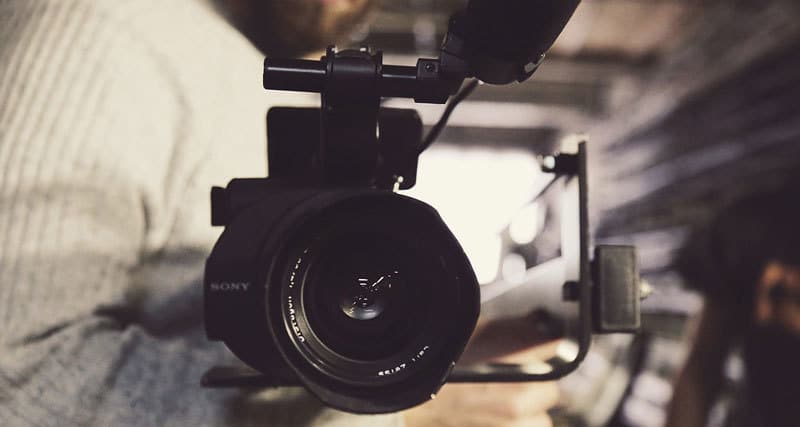
Publishing An SEO Optimized Video
When you publish your video onto YouTube you are effectively creating a new page on their domain that already has extremely high domain authority (SEOs call this ‘DA').
YouTube gives you a few fields that you can manipulate in order to optimize your new page for your target keyword you chose earlier.
It is always important to remember when optimizing any page or post (whether on YouTube or on your own blog) that you always have to appease two separate audiences.
- Writing For The Search Engine Algorithm
- Writing For Your Target Audience
If you only had to write for the algorithms, everything would be much more scientific and mathematical.
Writing for your target audience… The humans who will eventually find, click and watch your video require more of an art based approach.
This section is going to try and balance this “Part science and part art” approach to optimizing your video page…
You need to make educated guesses about what will work best in all these sections and you need to launch your video out to the world as best you can.
After the initial optimization, you will learn how to go deeper into the data and to leverage a specific YouTube SEO software to test, tweak, improve and refine your SEO for that video based on DATA!
Optimizing Your YouTube Video For The Search Algorithm
The YouTube algorithm is limited to a handful of datapoints the moment you click publish in order to understand what your video is about, what phrases it is relevant to and where to place you in the rankings.
- Your Title
- Your Description
- Your Tags
- Your Filenames
There are other factors, like your channel name, your past videos and the words you speak out in the video (via your closed captions track) but you can ignore those for now.
You already created a great video about your topic and keyword phrase, so your closed caption track (when it is available, it isn’t instant) will support your on-page optimization.
And your channel info is a TINY factor and for many personal channels or new channels, a factor that doesn’t really matter.
Quick reminder… You MUST blend the optimization for the algo discussed below WITH the optimization for the viewer to create a properly optimized video.
This is just HALF of the job!
To properly optimize your title, you need to get your exact keyword phrase as close to the beginning of the title as possible.
To properly optimize your description you need to get the exact keyword phrase in the first 120 characters of the description.
Also in the description, you want to get and any alternative keyword phrases that are extremely relevant to your core phrase in the description.
You should shoot for a minimum of 500 words of content in your description and many YouTubers are having great success running their audio track through Temi.com or Otter.ai to get a transcription and including the transcription as the full description.
YouTube Tags
For your tags, you want to include all possible relevant phrases about your core topic.
IMPORTANT!
You should include every tag you add inside of your description at least once!
If you have multiple tags that are simply variations of the same phrase, you can include one variation of the phrase so you don’t appear to be keyword stuffing..
You will want to search Google for your core phrase and look at the bolded terms, “Related Searches” and “People Also Ask” suggestions.
This is Google telling you EXACTLY what other phrases and questions are relevant to your topic!
Here are some images of those areas to find these relevant keyword variations.
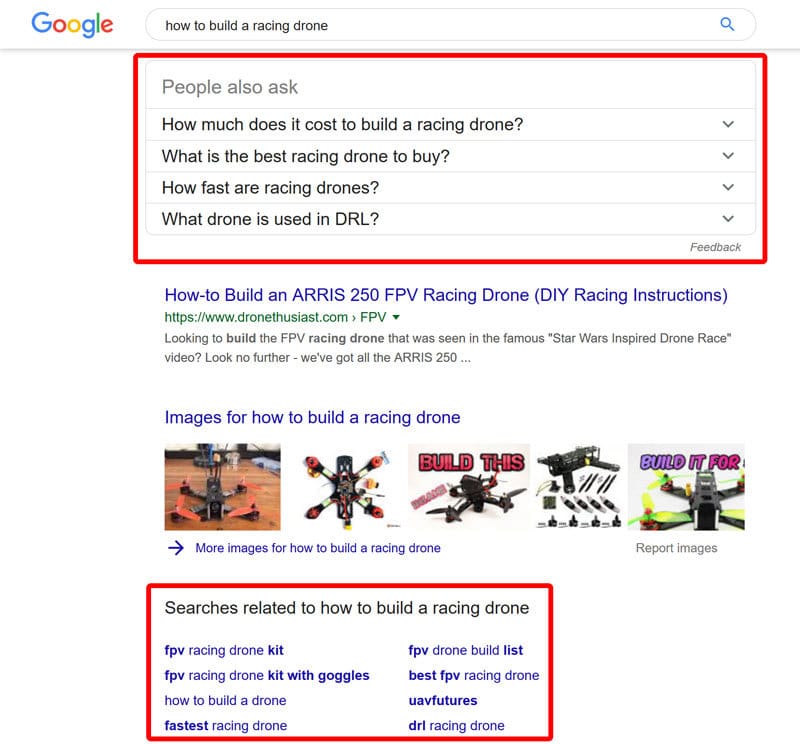
You can also pull relevant keyword phrases from the autocomplete suggestions on Google and YouTube both.
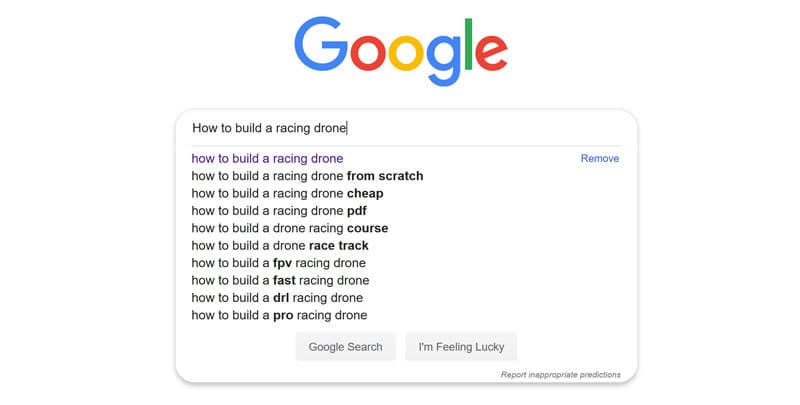
For your tags area you have 500 characters and I recommend you fill up as much as you can with relevant tags.
For your description area you have 5000 characters and for more difficult phrases you will need to add more unique and relevant content.
For your title area you have 100 characters and I recommend you utilize at least 70 characters. I often hit 90 – 99 characters of that limit.
Finally for the algo-optimization side is your video filename and your thumbnail filename.
Always name your .mp4 video file as your keyword phrase… And the same with your .jpg cover image.
For example…
how-to-build-a-racing-drone.mp4 would be my video filename that I upload and I would name the thumbnail image: how-to-build-a-racing-drone.jpg
Optimizing Your YouTube Video Page For Your Target Audience
If you only focus your on -page optimization for the YouTube algorithm you will never rank well, long term.
The reason being that end users will not connect with your content in a way that piques their interest and emotionally drives them to engage.
If your titles, descriptions, etc. are 100% focused on the keywords there is nothing that will invoke curiosity and compel your end user to click.
And this end user, again, is who the video is truly designed for.
Which means you will receive no engagement metrics, because of this lack of interest and interaction from the YouTube viewers.
How Important is Video Engagement?
No engagements, means your video will continue to drop lower and lower in the rankings.
So even if you perfectly optimize your video for your target keyword and YouTube places you on the 1st page right away…
The lack of engagement metrics, the low click-through-rate, the low view duration will all PROVE to YouTube that your video deserves less and less attention.
Therefore you will drop lower and lower in the rankings for your target keyword phrase.
Does this make sense? Understanding how to create your content for the algorithms AND for the viewers is KEY to your success.
And here-in-lies the ‘art’ side of the optimization process. The real art you must practice and master overtime is copywriting.
The art of “selling the click”to your viewer through your thumbnail image, your title and the first 120 characters of your description.
Because the title, description and thumbnail is all your users will see when they search for your topic.
Now, let’s break down visually all the ‘information’ your target audience has when searching for your video.
For this example we will use the keyword phrase “How to start a vlog” which gets searched 2925 times per month and has a ‘Difficulty Score’ of 26.
This is a relatively easy phrase for a YouTuber to DOMINATE based on the data, alone…
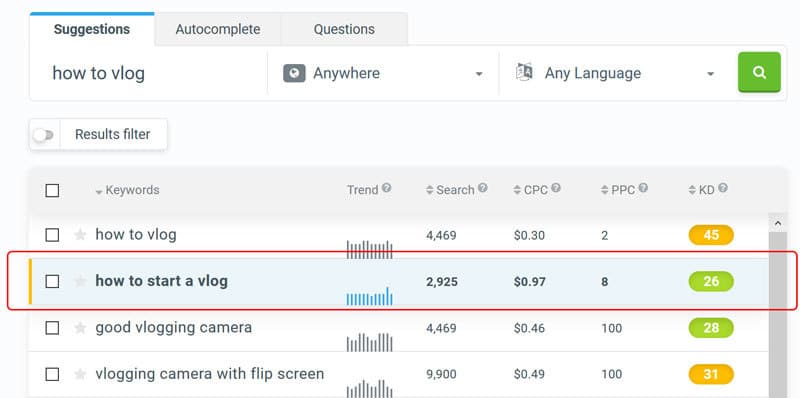
This keyword search was performed on the Keyword Finder Tool.
Now, when optimizing your YouTube video, you need to take time to search YouTube to survey your competition…
Below is a screenshot of the top of YouTube at the moment for that exact keyword phrase.
Notice the different components visible to the users after searching…
The thumbnails are the MOST attention grabbing component. The titles are the largest text (with the red arrows) and the first 120 characters of the description are displayed (circled in red)
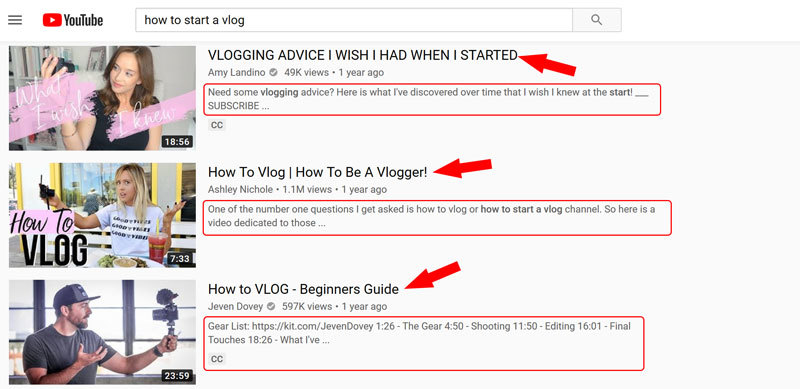
It is worth noting that the channel name, number of views and age of the video are displayed, but these are not editable at the time of publishing your optimized video.
Now comes the critical thinking part of optimizing your listing… How would you ‘Stand Out’ if you were targeting this keyword?
I'll give you my answer to that question, below to help you understand my thought processes here a bit more…
Thumbnail Image Optimization
I’d use an image of me in the act of vlogging… Because YouTube is showing us that is what people are clicking on! (Remember, higher click-through rate = higher rankings!)
I’d add words to the thumbnail, too… Maybe “Pro Vlogging Secrets Revealed” if that’d fit. The target size is 1280×720 px for the thumbnail and to save space it may need to be “Pro Vlogging Secrets.”
Again, I’m trying to evoke an emotional response to get the user to click… People LOVE to have secrets revealed to them!
Remember to save your thumbnail image as how-to-start-a-vlog.jpg too!
YouTube Title Optimization
Two of the three top videos say ‘How to vlog’ at the very beginning of the title, but none say ‘how to start a vlog’ so that’s how I’d out optimize them…
I’m also noticing the first video is using an emotional headline that induces a fear of missing out on important information…
Pro Tip: FOMO, or “The Fear Of Missing Out” is REAL and COMPELLING! Using FOMO can be a powerful way to build curiosity in your target viewer that can often get them to choose you over your competitors.
So my title would probably be something like:
“How To Start A Vlog & The 7 Fatal Mistakes You Must Avoid Or You’ll #FAIL”
I got the keyword right in at the very beginning… Perfectly optimized perfect for the algorithm.
Then I got some EMOTIONAL content that will COMPEL my target audience EMOTIONALLY to want to click for the fear of missing out and playing to the natural fear of failure.
Notice that? Written for BOTH the algorithm and the human!
Is it too far to say ‘Fatal Mistakes’ or ‘#FAIL’? I don't know, but I'd be willing to test it!
And, in just a minute I’ll show you how to let the data decide this for you with the advanced YouTube SEO tool in the next section.
But before you utilize that tool, you must publish your video, so getting it as optimized as you can at first is key.
YouTube Description Optimization
Next, in the description, I’m really focusing in on the first 120 characters to make sure I get the keyword phrase in there again AND more emotionally compelling content.
This is essentially your ‘sub-headline’ from a copywriting perspective.
Here’s what I’d put in the description for the first 120 characters
“Learn how to start a vlog the right way so you can publish videos you’ll be proud of. 7 keys to successful vlogging fast”
It is worth reminding you that the goal in the description is to write at least 500 words of relevant content about vlogging, how to info, summarizing your key points, etc.
Plus you want to link to the other relevant resources for the viewer on YouTube, to encourage a longer session duration.
Simple rule of thumb with links in your description: Publish more internal YouTube.com links than external non YouTube.com links!
Next, up… How to split test your video to boost your click through rate and video SEO.
Pro Level Video Optimization With The Best YouTube SEO Software
Personally, with about 500 videos created and over 91,000 subscribers in less than 3 years, I can say that this tool is an absolute game changer.
I wish this was available when I was just starting out because I’d have more subscribers and more views right now, for sure.
First off, the tool is TubeBuddy and you need their LEGEND account level.
You do not need to install the browser extension in order to leverage the SEO tool I show, below… It is all done within their website, itself.
If you are new to this tool, don't worry… I’ll walk you through the steps in detail below.
If you have been using TubeBuddy for a while, and haven’t been split testing for SEO, you are missing out and you are about to have a BIG “Ah Ha!” moment, guaranteed!
Ok, let’s begin.
Split Testing Your Videos To Improve SEO
First, the key theory here…
- The moment you launch your video, YouTube will place you in the search engine results page where it believes you belong based on the algorithm’s assessment of your video page.
- From that point on, YouTube’s algorithm begins monitoring your click through rate (CTR) and adjusts you in the rankings based on the CTR data.
- If your CTR is higher than the videos ranking above you… You’ll move up in the rankings.
- If your video is lower than the CTR of the videos below you… You’ll move down in the rankings.
Simple stuff, right?
This means, if you can continually increase your CTR, you'll continue to climb up in the rankings!
This is the big trick to YouTube SEO… And, this is where split testing comes in.
When you test a 2nd thumbnail image against your original, you will get data that proves which one has a higher click through rate.
When you test a 2nd title against your original, you will get data that proves which title has a better click through rate.
Same with your description field, too…
Testing the first 120 characters to increase your Click Through Rate (CTR) is the key to continually increasing your rankings.
And here’s the real gold mine.
With the new YouTube Studio Beta, you now have a new report available that will allow you to go through all your old videos to find the ones with below average CTR.
Then you apply this method of split testing to improve your SEO and click-through rate and you will start to see increases in video views and subscribers almost instantly.
How To Find Your Video Click Through Rate In YouTube Analytics
The first step is to log in to your YouTube account and go to the new YouTube Studio Dashboard (click here to open yours).
First click on “Analytics” on the left navigation and then click on “SEE MORE” at the bottom of the “Top Videos” box in the analytics screen.
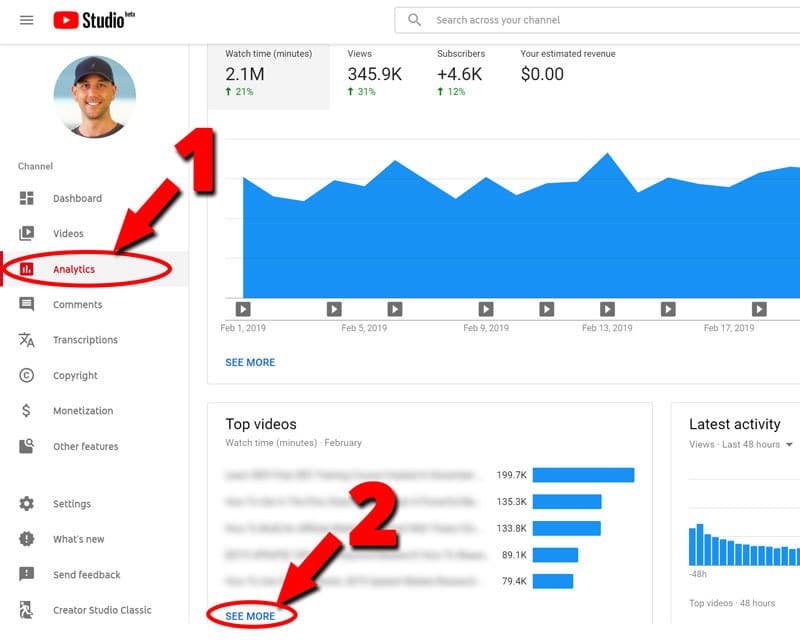
This will open a new report only available from within the YouTube studio that shows two key metrics you will use to optimize your videos for SEO and CTR.
The two metrics are ‘Impressions’ and ‘Impressions Click Through Rate’
You are going to use these two datapoints to identify your videos that have high impressions (meaning good rankings) and low click through rate (meaning there's room for improvement) so you can optimize them.
When this report loads after clicking the ‘See More’ link show at #2 in the above image, you will see your channel total on the top line of this new report, shown below.
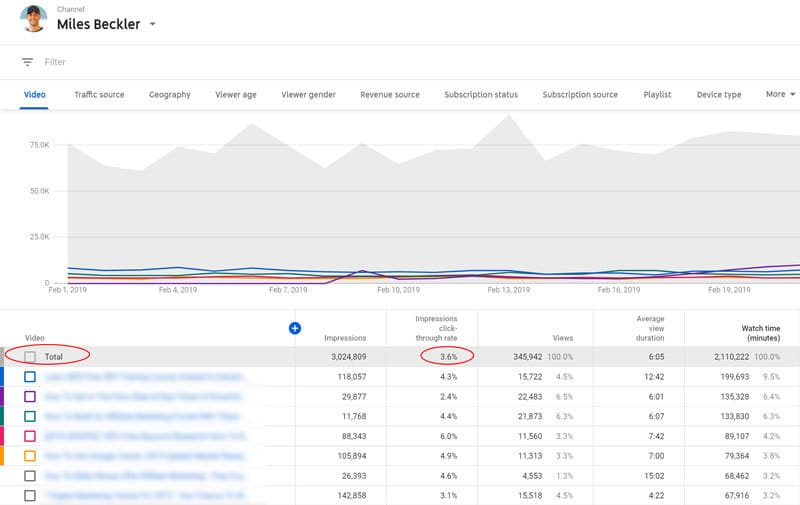
You can see above that my total CTR (Impressions Click Through Rate is the same as CTR) is 3.6 for the time period selected.
In the top right of this report (not shown, didn't have room) you have the option to change the date-range as needed. To start, I recommend you keep the report focused on the last 28 days or 90 days if you have less than 1000 subscribers.
From here, click on the ‘Impressions’ heading to sort this list by the videos that have the highest number of impressions up top. (See #1 in the below image)
You should see the highest number of impressions up top and all the data should be sorted in descending order based on the impressions. (#2 in the below image)
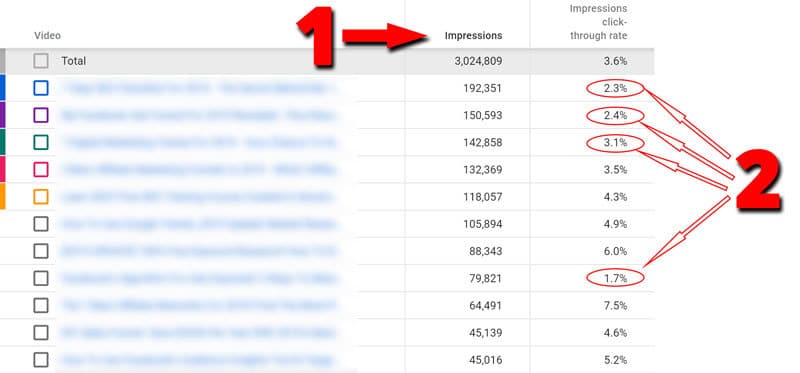
Right here, you are looking at your videos that get shown most by YouTube’s algorithm.
Now you simply look for the videos that have a below average click through rate (See #2 in the below image)
These are the videos that get the least engagement from your target audience meaning you have the largest room for improvement.
These are the videos you will optimize for search through split testing.
At this point, you should make a list of 5 – 10 videos that you’ve published that have a very high number of impressions and a lower-than-average click-through-rate.
Next, you will learn how to set up the split test so you can scientifically improve the click through rate.
This will result in an instant increase in YouTube views because a larger percentage of your current impressions will click on your videos vs. your competitors.
Then, over the course of the next 7-14 days when YouTube sees your CTR increasing they will move your video higher and higher in the search rankings because you’re giving your viewers a better experience.
How To Setup A Split Test In YouTube
Again, to execute this advanced YouTube marketing strategy, you need the Legend level of TubeBuddy which you can get by clicking here.
Once you have your account setup, you need to connect your YouTube channel and authorize the app to make changes to your channel.
Reminder… You do not need to install their browser extension. You’ll do all the split testing right from within their dashboard.
Ready to start? Great.
I’ll guide you thorough the whole process below with text and step-by-step images.
Step 1 – Add your channel
Step 2 – Click “A/B Tests” option
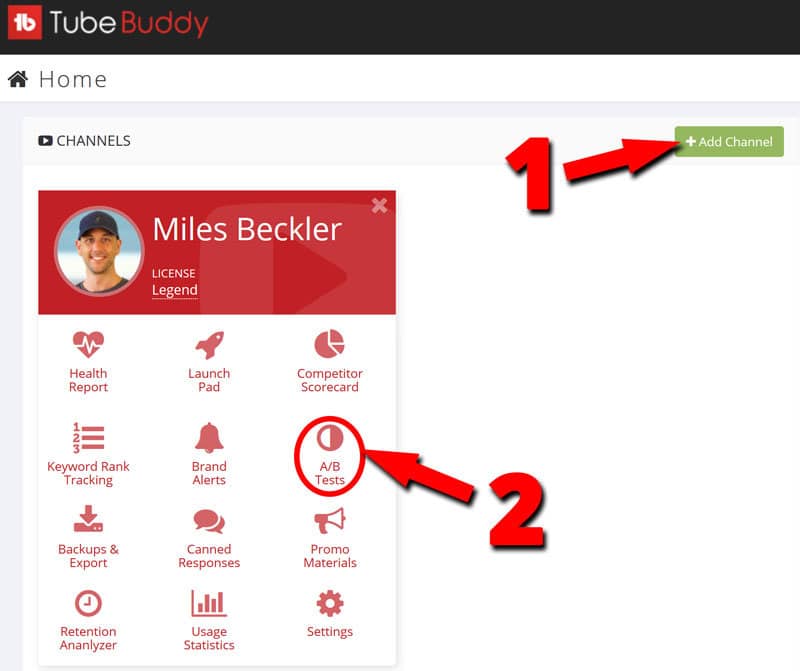
Step 3 – Click the green ‘Create A/B Test’ button.
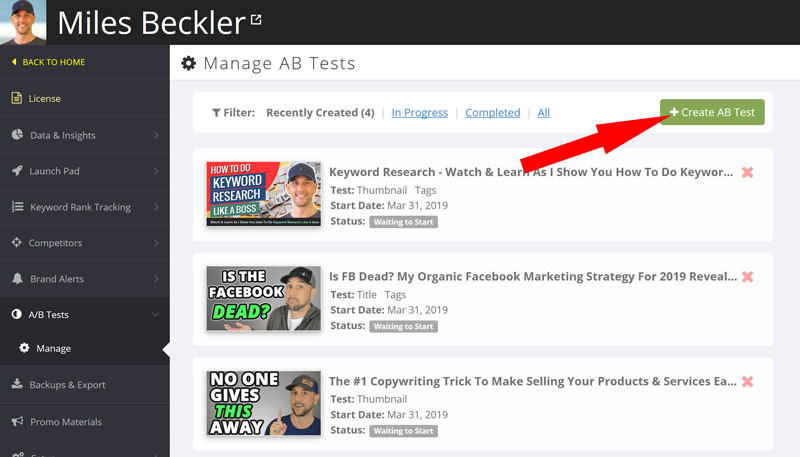
Step 4 – Choose your video that you want to run a split test on to optimize. You have two choices about how to choose your video.
- Option A: Choose one of the most recent videos by clicking on the thumbnail.
- Option B: Type in the title of the video to search through your older videos.
I've circled each option in red in the below picture so you can see clearly, the two ways to select your video.
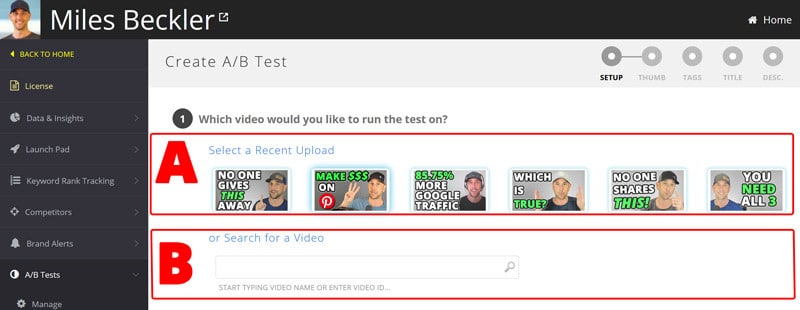
Step 5 – Once you have selected the video, you now need to choose the test type…
First option is to simply split test the thumbnails with the “Thumbnail CTR Test” option on the left. Honestly, this is where I'm focusing most of my energy because the thumbnail is the biggest ‘attention grabber' from the search results page.
The second option, on the right is to perform a “Metadata Test” which is more like a multivariate test.
This second option allows you to test the thumbnail, title, description and/or tags. You can test just one thing, like title or you can test everything by creating a second title, thumbnail, description, etc.
See the screenshot below shows both options:
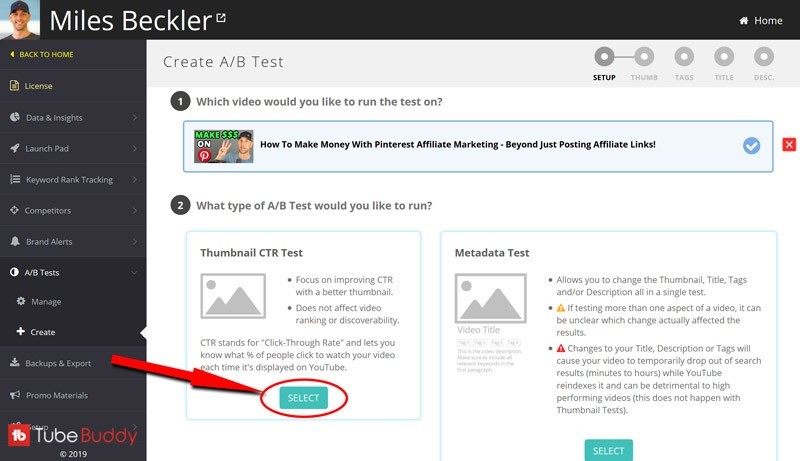
Now, before you go testing EVERYTHING at the same time, remember this about split testing.
When you test two variables at the same time… For example if you test the thumbnail AND the title at the same time… You will have no way of knowing WHICH item accounted for your increase or decrease in CTR.
The best approach to split testing is to test 1 variable at a time… I recommend starting with the thumbnail first, then the title after a clear winner appears from the thumbnail test.
Third, I'd test the first 120 characters of the description, but honestly, I'd move on to the next video after getting the CTR above average with the thumbnail and title.
For this tutorial, I'm going to stick with the first option, to test the thumbnail, on the left.
Step 6 – Once you choose the test type, your next option is to choose the test duration (seen below)
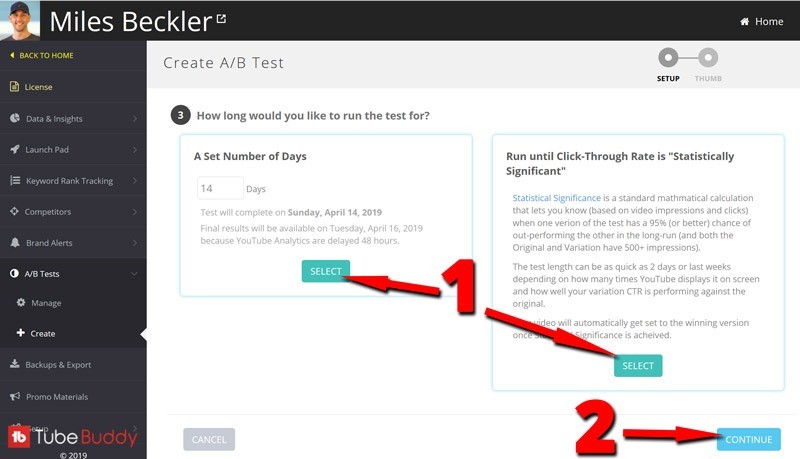
The options are simple…
If you have a high traffic channel and your videos are receiving hundreds of views (or thousands) per day, choose the option on the right “Run Until Statistically Significant”
If your channel is growing and you don't receive hundreds of views on each video per day, choose the number of days option and go with either 7 days or 14 days.
14 days will bring you better data, and it is best if you wait until you have at least 500 impressions on each.
Data can be messy with small sample sizes, so you want to get to statistical significance so you can rely on the data!
Step 7 – At this point you are ready to add your new thumbnail:
Just click the ‘Browse' button and choose your new thumbnail you wish to test against your control…
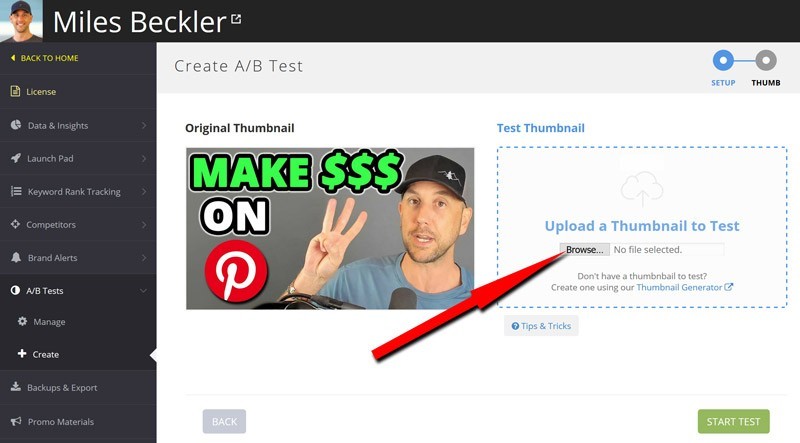
This loads your new thumbnail file and you simply need to click the “Start Test” button.
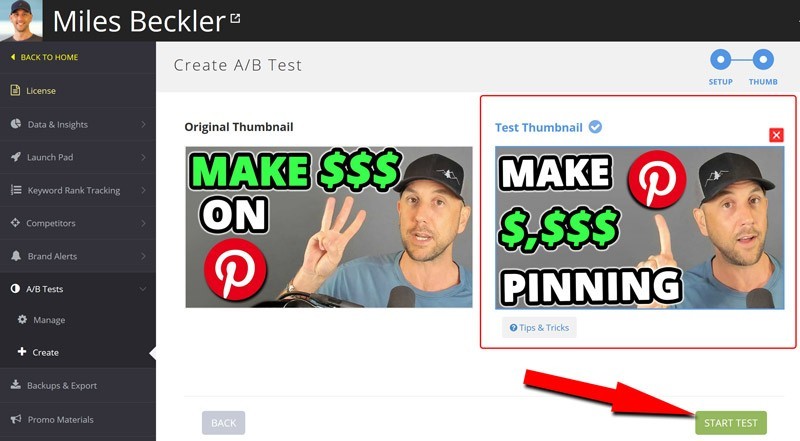
You will get a confirmation pop up explaining how the testing works on YouTube, then you just click “Yes! Start The Test”

And that's it!
You've now got your first YouTube SEO split test up and running. You can run 10 at a time with this tool and I recommend you to always be testing!
This is the #1 proven way to increase your click through rates which will increase your traffic and rankings.
If there ever was a new and exciting YouTube SEO hack, this is it.
The reporting takes 4 days to show up… The tool will show one thumbnail for a full day, then it changes the other image for the next day, which means it takes 2 full days to accrue data.
Then, YouTube's reporting is delayed by 48 hours which means you need another 2 days to see the data.
Once you have at least 500 impressions on each test, you can choose the one that has the highest click through rate to conclude your test and go back to setting up the next split test!
With a little patience and persistence, you will be able to optimize your videos to a new level to generate more clicks, more views, more engagements…
All in all you'll be able to grow your channel faster than ever before!
If you have any questions about this process, the tool or for me, leave a comment below!
Cheers.
Miles “Happy YouTuber” Beckler


